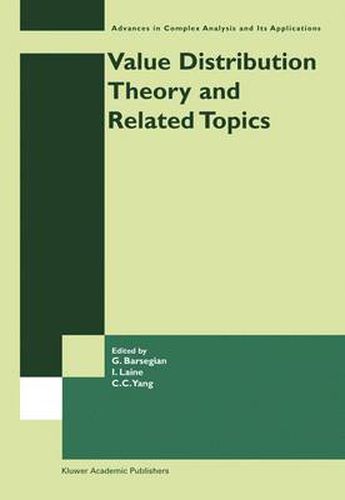Readings Newsletter
Become a Readings Member to make your shopping experience even easier.
Sign in or sign up for free!
You’re not far away from qualifying for FREE standard shipping within Australia
You’ve qualified for FREE standard shipping within Australia
The cart is loading…






This title is printed to order. This book may have been self-published. If so, we cannot guarantee the quality of the content. In the main most books will have gone through the editing process however some may not. We therefore suggest that you be aware of this before ordering this book. If in doubt check either the author or publisher’s details as we are unable to accept any returns unless they are faulty. Please contact us if you have any questions.
The Nevanlinna theory of value distribution of meromorphic functions, one of the milestones of complex analysis during the last century, was c- ated to extend the classical results concerning the distribution of of entire functions to the more general setting of meromorphic functions. Later on, a similar reasoning has been applied to algebroid functions, subharmonic functions and meromorphic functions on Riemann surfaces as well as to - alytic functions of several complex variables, holomorphic and meromorphic mappings and to the theory of minimal surfaces. Moreover, several appli- tions of the theory have been exploited, including complex differential and functional equations, complex dynamics and Diophantine equations. The main emphasis of this collection is to direct attention to a number of recently developed novel ideas and generalizations that relate to the - velopment of value distribution theory and its applications. In particular, we mean a recent theory that replaces the conventional consideration of counting within a disc by an analysis of their geometric locations. Another such example is presented by the generalizations of the second main theorem to higher dimensional cases by using the jet theory. Moreover, s- ilar ideas apparently may be applied to several related areas as well, such as to partial differential equations and to differential geometry. Indeed, most of these applications go back to the problem of analyzing zeros of certain complex or real functions, meaning in fact to investigate level sets or level surfaces.
$9.00 standard shipping within Australia
FREE standard shipping within Australia for orders over $100.00
Express & International shipping calculated at checkout
This title is printed to order. This book may have been self-published. If so, we cannot guarantee the quality of the content. In the main most books will have gone through the editing process however some may not. We therefore suggest that you be aware of this before ordering this book. If in doubt check either the author or publisher’s details as we are unable to accept any returns unless they are faulty. Please contact us if you have any questions.
The Nevanlinna theory of value distribution of meromorphic functions, one of the milestones of complex analysis during the last century, was c- ated to extend the classical results concerning the distribution of of entire functions to the more general setting of meromorphic functions. Later on, a similar reasoning has been applied to algebroid functions, subharmonic functions and meromorphic functions on Riemann surfaces as well as to - alytic functions of several complex variables, holomorphic and meromorphic mappings and to the theory of minimal surfaces. Moreover, several appli- tions of the theory have been exploited, including complex differential and functional equations, complex dynamics and Diophantine equations. The main emphasis of this collection is to direct attention to a number of recently developed novel ideas and generalizations that relate to the - velopment of value distribution theory and its applications. In particular, we mean a recent theory that replaces the conventional consideration of counting within a disc by an analysis of their geometric locations. Another such example is presented by the generalizations of the second main theorem to higher dimensional cases by using the jet theory. Moreover, s- ilar ideas apparently may be applied to several related areas as well, such as to partial differential equations and to differential geometry. Indeed, most of these applications go back to the problem of analyzing zeros of certain complex or real functions, meaning in fact to investigate level sets or level surfaces.